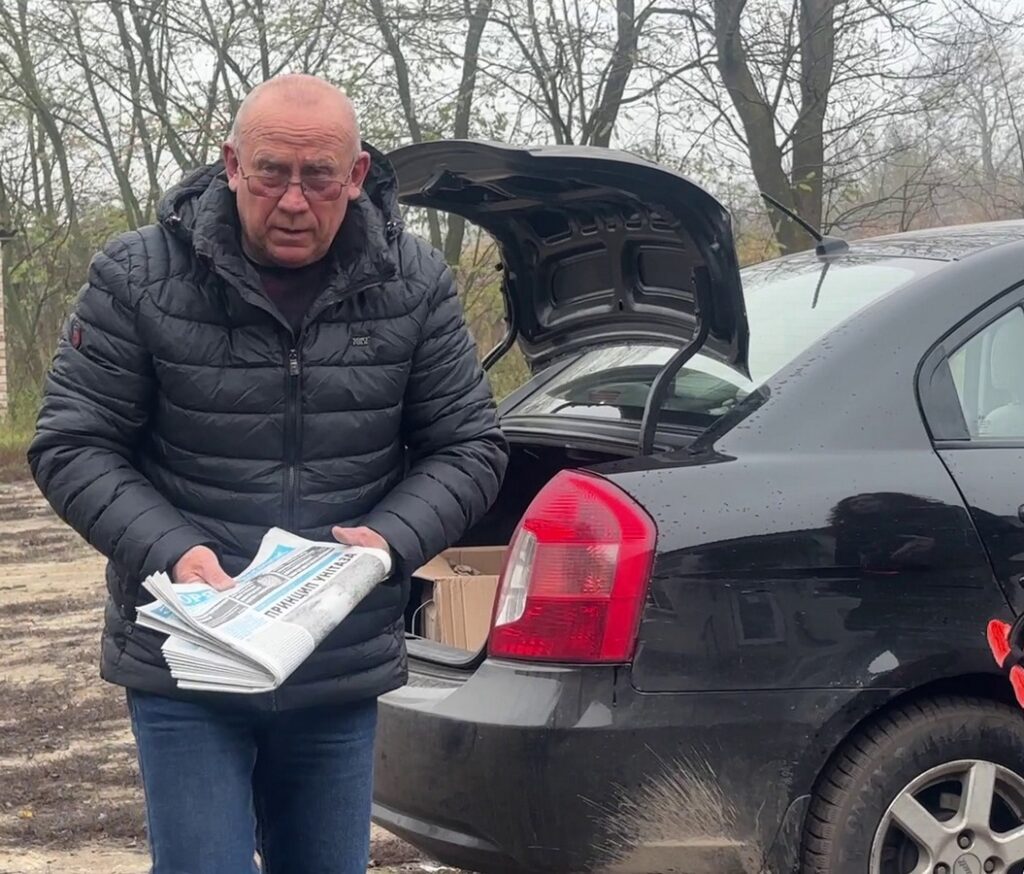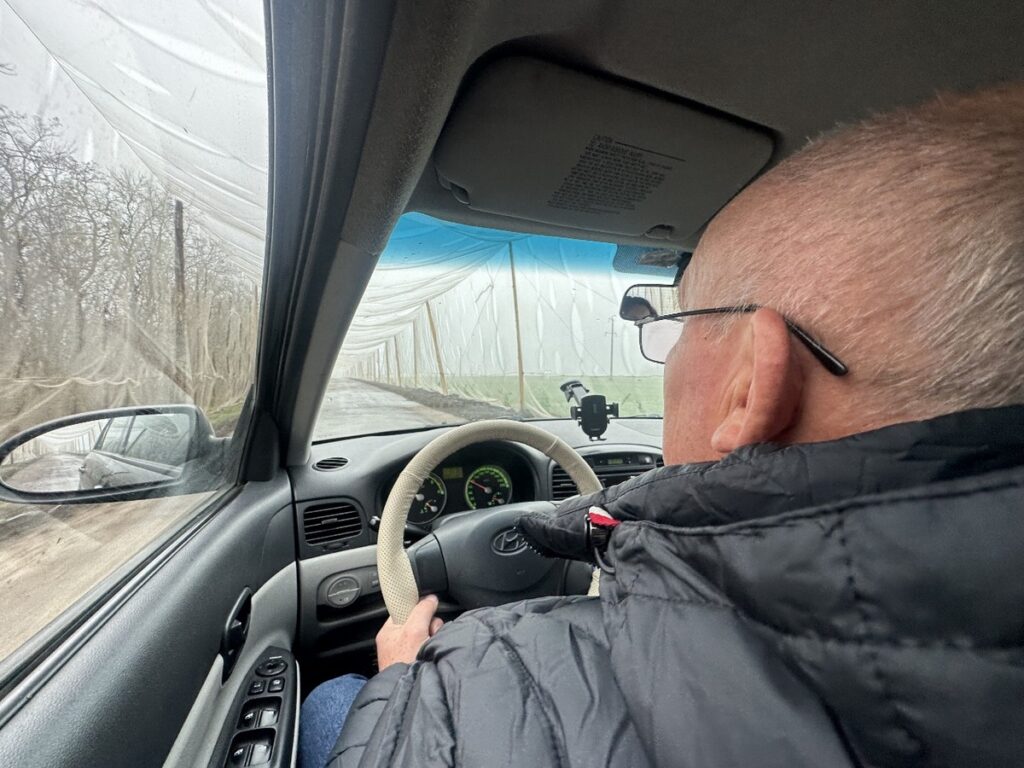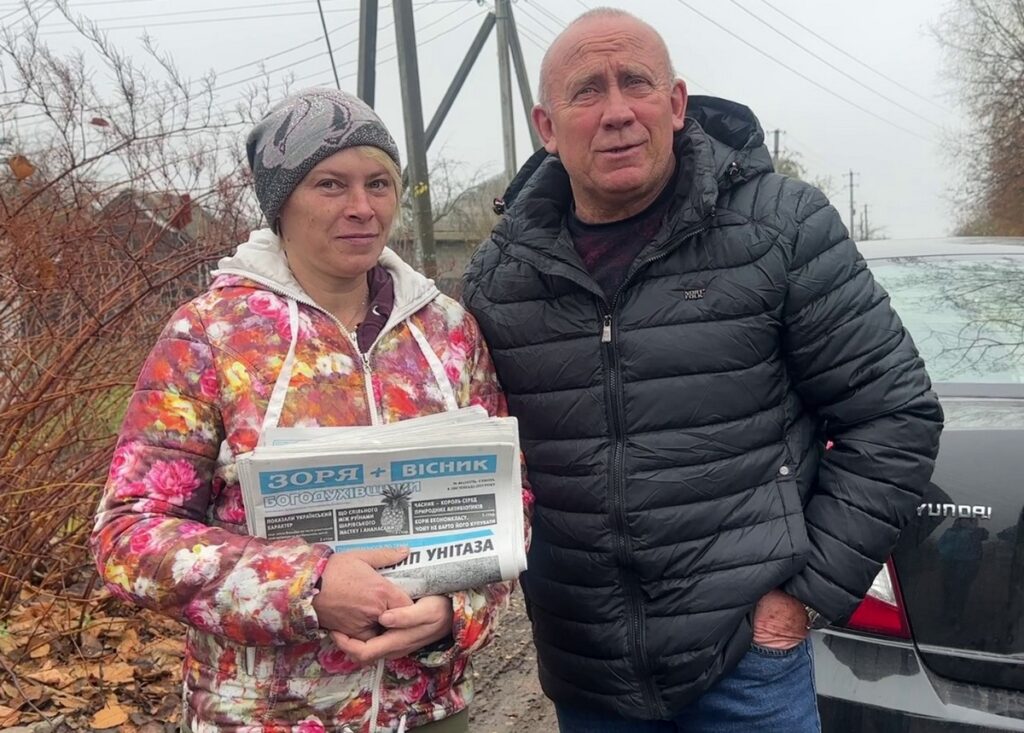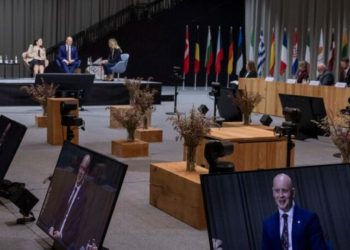“Many of the people who were in the frame are no longer there – they were killed or they were evacuated,” says the main character of the documentary / journalist from the town of Zolochiv, Vasyl Myroshnyk. Since April 2024, when journalists from the information service of the National Union of Journalists of Ukraine (NUJU) filmed the documentary called On the Edge on the Kharkiv border, many dramatic changes have occurred there.
A year and a half ago, the film crew accompanied Vasyl Myroshnyk, the editor-in-chief of the newspaper Zoria – Visnyk Bohodukhivshchyny, on his route along the frontline roads of the Kharkiv Region. Vasyl Myroshnyk covered 400 kilometers every week, delivering the newspaper to villages near the border with russia. Unfortunately, this path has now become impossible.
Attack of a Drone
Earlier, during the filming of the film in the spring of 2024, Vasyl Myroshnyk traveled along the route from Odnorobivka to Ivashky to Oleksandrivka. These are villages 50-100 meters from the border with russia. Back then, he could still get there, albeit with great risk.
The last time Vasyl Myroshnyk traveled to the village of Odnorobivka was a month ago. This is one of the settlements closest to the border, where he had been distributing a newspaper since the very beginning of the full-scale invasion. He unloaded at the store, as usual.

Returning, he entered an area where the road was covered with a net – a kind of tunnel that was supposed to protect against drones. Driving for about 10-15 minutes under this protection gave a feeling of safety, albeit relative.
– You’re always on adrenaline in Odnorobivka, and you dive in there – and it seems easier, – the editor describes his feeling.
But this time, the calm was deceiving. The drone flew under the net following Vasyl Myroshnyk’s car.
“I’m driving, in the rearview mirror I clearly see a small drone – flying, buzzing,” the journalist recalls. “To be honest, I rushed so much that… There’s only one way – forward. I literally flew to the bridge that was on the road – and there in front of the bridge, the drone fell.”
The editor says that he has long stopped thinking that drones on the border hunt for the military or important, or influential people.
“They kill everyone they meet. These are such “jokes” of the russians,” Vasyl Myroshnyk suggests. “What happened to me is not an exception, but the norm for the border villages of the Kharkiv Region. A retired couple was driving in an old blue Tavria – a mine was thrown right at their hood. These were people who had spent their entire lives in the village of Skoryky, outside Odnorobivka. Or young guys were driving a combine – a mine went off. One died, the other survived but was injured. Grandma left the house – the drone hovered in front of her eyes and started chasing her. She managed to jump back into the house, and it smashed the neighboring house. It didn’t hit Grandma, but the woman almost died of a heart attack… You drive and see these endless fiber-optic threads from drones – there are as many of them as spider webs on a summer day. They are entwined on poles, on trees.”

A week later, the bridge to Odnorobivka, near which the drone fell, was remotely blown up by the russians – and the village became cut off from the rest of the community.
“We Became Afraid to Walk the Streets”
The stories of other villages and people told in the film also received a sad continuation.
In Oleksandrivka, there lived a heroic woman, a former mail carrier, Maryna, from whose window you could see russians abroad. She helped Vasyl Myroshnyk sell 60 newspapers. Two weeks ago, two drones flew right into the entrance of her house, climbed to the second floor, and worked there.
“Maryna called me: ‘Vasyl Myroshnyk, I’m very sorry, but I probably won’t be helping you anymore,” Vasyl Myroshnyk recounts the conversation. “I say: “Maryna, what happened?” She says, ‘Really, I’m afraid to go outside. We became afraid to walk the streets. These 60 copies need to be delivered. I need to take the newspapers and walk down the street. I’m afraid.”
Oleksandrivka was completely removed from the route.
In Timofiyivka, where there used to be 20 newspaper readers, the russians hung their flag on the water tower. Now there is not a single person there.
Drones are constantly flying overhead in Ivashka. Going there means risking your life “without a chance.”
“Of course, I am not a coward, but I am not a fool either. I see no point in going where I will be killed 100 percent of the time,” says Vasyl Myroshnyk.
Now, the furthest the editor travels is 5 kilometers to the border: Liutivka, Riasne, and Pysarivka. Then he travels through the villages of the Bohodukhiv Community: Dmytrivka, Ulianivka, and Voskresenivka.

“I changed routes, I am losing circulation, I am losing readers.”
The newsroom of Zoria, which was previously published in Zolochiv as an independent newspaper, was shelled at least eight times. It had to be merged with another publication headed by Vasyl Myroshnyk, Visnyk Bohodukhivshchyny. But the circulation of the merged publication also decreased from 4,700 to 2,800 copies – almost half.
The newspaper changed its printing location after the shelling of the Kharkiv printing house; now the publication is printed in Chernivtsi and delivered by the Nova Poshta private postal service. Because of this, there is no clear schedule – the newspaper may arrive on any day of the week, including Thursday, Friday, Saturday, or Sunday.

“Nova Poshta does not deliver very well to Zolochiv,” said the editor, explaining his experiencing logistical problems. “They see these concerns, they simply don’t go during that period. And they are doing the right thing, and they don’t have to go.
This is a different reality compared to the one that existed during the filming of the film in the spring of 2024. Then there were drones too, but their use against civilians was not so systematic and ruthless.
“I changed routes, I am losing circulation, I am losing readers,” Myroshnyk concludes. “I am very pleased with the attention of the National Union of Journalists of Ukraine (which made a wonderful film), and I appreciate the support of its President, Sergiy Tomilenko. I understand the sincerity of my colleagues and am grateful. They hoped that my story, which was told in the documentary, in particular, would help our newsroom receive financial assistance from donors. It is a pity that this has not happened.”
The newsroom is trying to compensate for part of the losses in printed circulation by developing digital content. The Facebook group Visnyk Bohodukhivshchyny is growing by 20-50 people every day, and the number of subscribers has already surpassed 10,000. This gives hope that the word is still reaching people, albeit through other channels.
The latest high-profile material, about the pollution of the river in Bogodukhiv, has attracted many new readers. Based on the publication’s results, the prosecutor’s office even opened a criminal case, which Vasyl Myroshnyk considers a significant achievement.
The editorial team also started earning money on YouTube – though, after YouTube refused to monetize it for a long time, explaining that, they say, the editorial team “earns authority by showing off the war”. Now, some kopecks from YouTube are still coming in, and this is also a small victory.
Vasyl Myroshnyk is not going to stop working. For now, the editorial team is holding on thanks to the enthusiasm of the editor and his daughter, Lesia Babkina, who works with him, as well as the support of the NUJU.
“It’s Ok! We’ll break through slowly anyway,” concludes Vasyl Myroshnyk.

Maksym Stepanov
NUJU Information Service

 THE NATIONAL UNION OF
JOURNALISTS OF UKRAINE
THE NATIONAL UNION OF
JOURNALISTS OF UKRAINE
















Discussion about this post